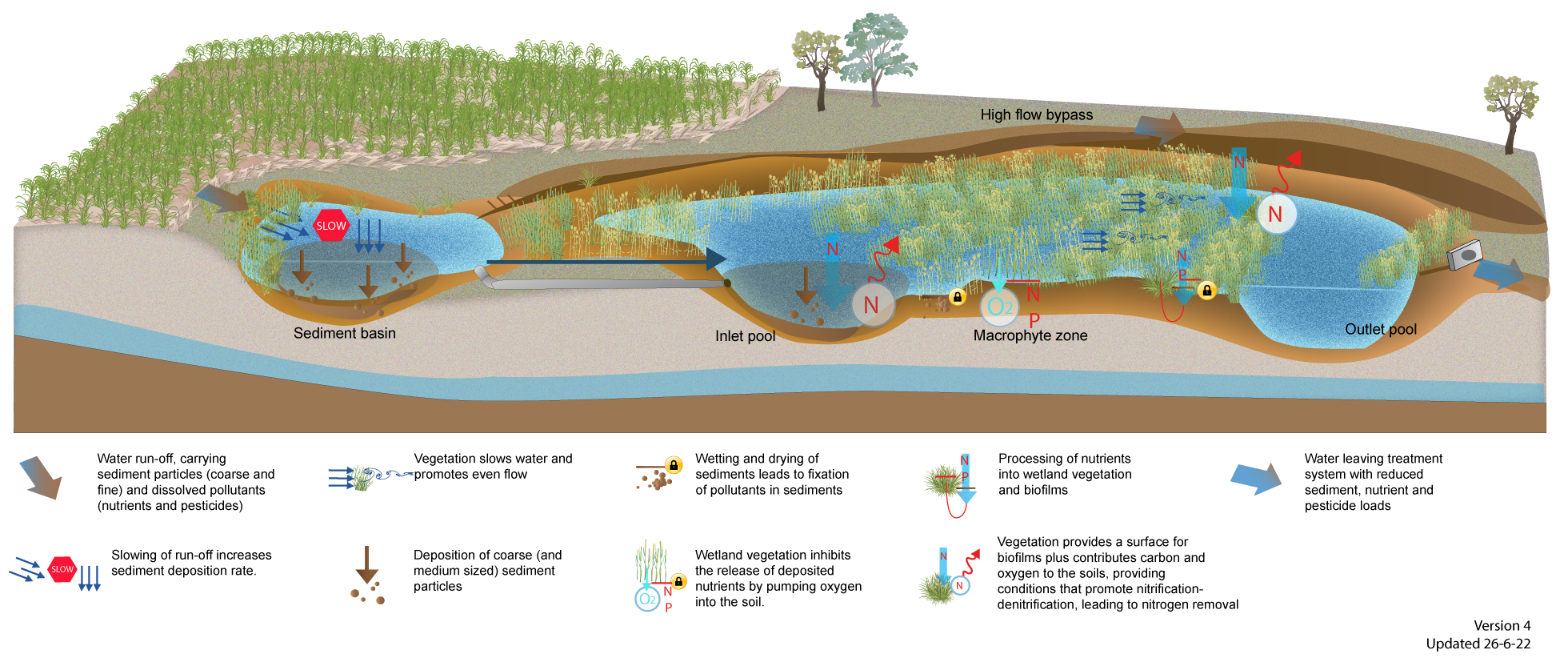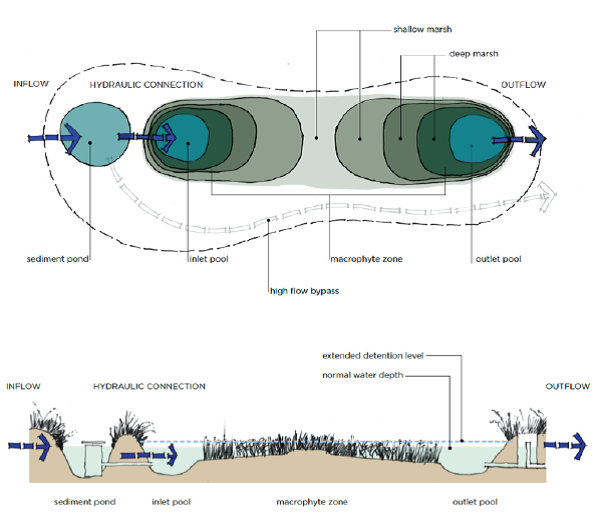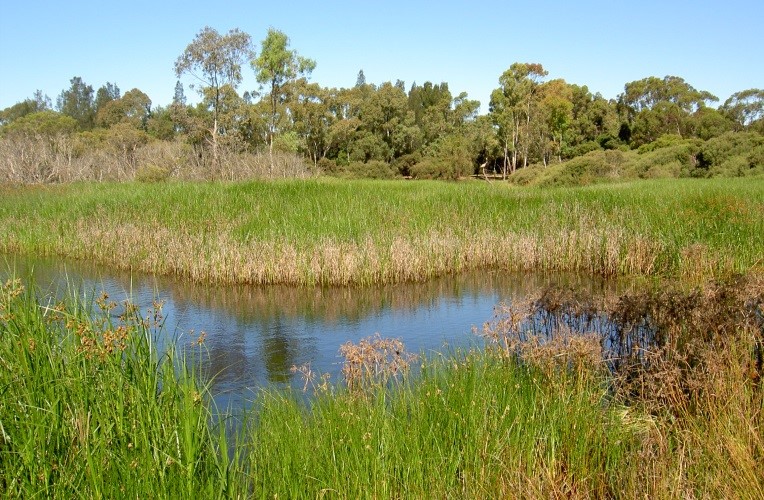|
|
Treatment wetlandsTreatment wetlandsSelect from the tabs below Other name/sConstructed wetlands, landscape wetlands, embellished wetlands, surface flow wetlands, free-water wetlands Note this does not include sub-surface flow or vertical wetlands. These systems require a gravel or rock medium, which is unlikely to be cost-effective in treating the volumes of water required in many Queensland agricultural systems. DescriptionTreatment wetlands are engineered systems that replicate and enhance the physical, biological and chemical treatment processes occurring in natural wetlands to remove fine sediments, nutrients and other pollutants (e.g. pesticides, heavy metals)[9][4]. They differ from restored or natural wetlands in that they are designed and managed primarily to improve water quality. Although treatment wetlands can be designed to provide other co-benefits in addition to water treatment, such as aesthetics and wildlife habitat. To create or rehabilitate wetlands for other purposes or ecosystem services, refer to aquatic ecosystem rehabilitation. Used extensively to treat primary and secondary municipal sewage, landfill leachate, urban stormwater run-off and industrial wastewaters, treatment wetlands are equally suited to improving water quality in agriculture and aquaculture[4][3]. Treatment wetlands are generally designed to intercept surface flows (rainfall or irrigation run-off or wastewater) and can also be effective at treating shallow groundwater[7]. They can be formed through extensive earthworks to create a relatively uniform bathymetry or through relatively minor earthworks and hydrological modifications to retain water and support conditions conducive to macrophyte growth and water treatment (i.e. landscape wetlands) (Figure 1). Particulate matter, nutrients, and toxicants are removed through:
Treatment wetlands are often one of the last elements in a treatment train, to remove fine sediments, nutrients and some toxicants. It is essential to minimise the amount of coarse sediment entering treatment wetlands, through best management practices, sediment basins, vegetated drains and vegetated buffers and swales to prevent smothering of vegetation, damage and costly maintenance.
Case study: Treatment train approach on a banana farm Treatment wetlands are generally around 0.3-1m deep with over 50% (ideally 80%) of the area vegetated with macrophytes (e.g. reeds and sedges)[5]. A treatment wetland will typically include (Figure 2):
The macrophyte zone is the critical part of a treatment wetland. Without dense vegetation covering at least half of the wetland surface, wetlands will act more like a sediment basin (i.e. removing sediment and some particulate nutrients). Dense vegetation provides the environment for nitrification/denitrification, to remove nitrogen, specifically nitrate[7]. The macrophyte zone is designed to also facilitate enhanced sedimentation of fine particles (<125µm) and the biological and chemical removal of nutrients and some pesticides. Vegetation is important to:
Note that treatment performance is compromised if vegetation growth is excessive, for instance if the treatment wetland is overgrown with weeds. In this case, water stagnates with very low or no dissolved oxygen, limiting nitrification and in turn denitrification[7]. These conditions can lead to high dissolved organic nitrogen or ammonium export and even methane and nitrous oxide emissions[7][6]. Hence vegetation management is important, refer to the establishment and maintenance sections for more information. Effectiveness as a treatment systemWell-located, designed and managed treatment wetlands in Queensland can reduce dissolved inorganic nitrogen (DIN) by approximately 80%[5]. Effective treatment wetlands have the following conditions that favour nitrification/denitrification. These are potential indicators of wetland nitrogen removal performance[5][7]: With these conditions, treatment wetlands in agricultural areas can remove a kilogram of DIN for less than $50[5]. This cost-effectiveness calculation includes design, project management, construction, plant establishment and maintenance costs. The actual cost-effectiveness of a treatment wetland will vary for each individual site. The cost-effectiveness needs to be considered relative to other treatment systems or management intervention options. Refer to cost considerations for more information.
Services and benefits
The information provided in the following pages is specific to enhancing the water treatment capacity of treatment wetlands. Changes to the design to provide habitat or amenity may reduce the treatment effectiveness of the treatment wetland. For information on other constructing or restoring wetlands for other purposes refer to aquatic rehabilitation. DisclaimerIn addition to the standard disclaimer located at the bottom of the page, please note the content presented is based on published knowledge of treatment systems. Many of the treatment systems described have not been trialled in different regions or land uses in Queensland. The information will be updated as new trials are conducted and monitored. If you have any additional information on treatment systems or suggestions for additional technologies please contact us using the feedback link at the bottom of this page. References
Last updated: 24 May 2022 This page should be cited as: Department of Environment, Science and Innovation, Queensland (2022) Treatment wetlands, WetlandInfo website, accessed 8 May 2025. Available at: https://wetlandinfo.des.qld.gov.au/wetlands/management/treatment-systems/for-agriculture/treatment-sys-nav-page/constructed-wetlands/ |

 — Department of the Environment, Tourism, Science and Innovation
— Department of the Environment, Tourism, Science and Innovation






